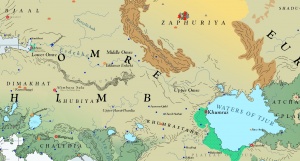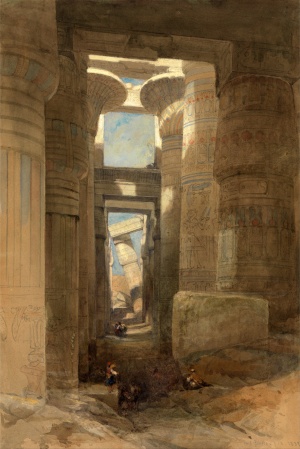Difference between revisions of "Omre"
Trismegistus (talk | contribs) m |
Trismegistus (talk | contribs) m |
||
| Line 1: | Line 1: | ||
| − | Omre [Anglicized Pronunciation: /ˈɔmˌrɛɪ/ or /ˈɔmˌrɪ:/] is an ancient land in [[Disradún]] and well-known for its many temples and spiritual teachings. Its [[antediluvian]] predecessor was the [[Hmœssite Civilization]], contemporary with that of the Aarokinian Titans. Omre is a semi-tropical plain resting between [[Sahimb]] and [[Ukelia]]. The [[Esdekhel River]] is the dominant feature of the land. The southern boundary of the land is bounded by the [[Djakhihut Mountains]]. Omre can be divided into three regions, [[Lower Omre]] where the mouth of the [[Esdekhel River]] dumps into the [[Titans Sea]], [[Middle Omre]] where the city [[Eddanas Enkeki]] rests, and [[Upper Omre]] where the Esdekhel River originates. | + | Omre [Anglicized Pronunciation: /ˈɔmˌrɛɪ/ or /ˈɔmˌrɪ:/] is an ancient land in [[Disradún]] and well-known for its many temples and spiritual teachings. Its [[antediluvian]] predecessor was the [[Hmœssite Civilization]], contemporary with that of the Aarokinian Titans. Omre is a semi-tropical plain resting between [[Sahimb]] and [[Ukelia]]. It is subject to both droughts and flooding. The [[Esdekhel River]] is the dominant feature of the land. The southern boundary of the land is bounded by the [[Djakhihut Mountains]]. Omre can be divided into three regions, [[Lower Omre]] where the mouth of the [[Esdekhel River]] dumps into the [[Titans Sea]], [[Middle Omre]] where the city [[Eddanas Enkeki]] rests, and [[Upper Omre]] where the Esdekhel River originates from the large inland sea known as the [[Waters of Tjur]]. |
[[File:Map Omre Disradun Geo.jpg|thumb|300px|The land of Omre is historically defined by the [[Esdekhel River]] which flows from the east to the western sea.]] | [[File:Map Omre Disradun Geo.jpg|thumb|300px|The land of Omre is historically defined by the [[Esdekhel River]] which flows from the east to the western sea.]] | ||
| Line 8: | Line 8: | ||
[[File:DavidRoberts+GreatTempleofAmonKarnakHypostyleHall+1838+PublicDomain.jpg|thumb|300px|Ruins of Omre.]] | [[File:DavidRoberts+GreatTempleofAmonKarnakHypostyleHall+1838+PublicDomain.jpg|thumb|300px|Ruins of Omre.]] | ||
| + | |||
| + | =Esdekhel River= | ||
| + | {{Main|Esdekhel River}} | ||
| + | The Esdekhel River has historically played an enormous role in the social, economic, religious, and cultural development of Omre. It is navigable well into Upper Omre and its flooding feeds the many crops of the Esdekhelite river valley. The river has been worshiped as a divinity since ancient times. | ||
=Chronology of Omre= | =Chronology of Omre= | ||
| Line 33: | Line 37: | ||
;Bajamaic Rule (local Incarnandist rulers) 2358 to ca 2400 | ;Bajamaic Rule (local Incarnandist rulers) 2358 to ca 2400 | ||
;Free Kingdom (three dynasties) 2397 to ca 2750 | ;Free Kingdom (three dynasties) 2397 to ca 2750 | ||
| − | |||
| Line 41: | Line 44: | ||
*LATE BRONZE: 2200 to 1850 AS | *LATE BRONZE: 2200 to 1850 AS | ||
*IRON AGE: 1850 AS to 200 AS | *IRON AGE: 1850 AS to 200 AS | ||
| − | |||
Revision as of 18:48, 15 October 2023
Omre [Anglicized Pronunciation: /ˈɔmˌrɛɪ/ or /ˈɔmˌrɪ:/] is an ancient land in Disradún and well-known for its many temples and spiritual teachings. Its antediluvian predecessor was the Hmœssite Civilization, contemporary with that of the Aarokinian Titans. Omre is a semi-tropical plain resting between Sahimb and Ukelia. It is subject to both droughts and flooding. The Esdekhel River is the dominant feature of the land. The southern boundary of the land is bounded by the Djakhihut Mountains. Omre can be divided into three regions, Lower Omre where the mouth of the Esdekhel River dumps into the Titans Sea, Middle Omre where the city Eddanas Enkeki rests, and Upper Omre where the Esdekhel River originates from the large inland sea known as the Waters of Tjur.

Omre is Zumdash in the Khahonri Language.
Modern Omre is a kingdom. The king has signifcant power, limited by the Supreme Assembly of Magistrates which consists of regional and municipal governors, including priests. The modern capital of Omre, Jehmu, rests on the mouth of the Esdekhel River. Other great cities include Penkardash and Eddanas Enkeki.
Esdekhel River
The Esdekhel River has historically played an enormous role in the social, economic, religious, and cultural development of Omre. It is navigable well into Upper Omre and its flooding feeds the many crops of the Esdekhelite river valley. The river has been worshiped as a divinity since ancient times.
Chronology of Omre
Ancient Name Khijira-Nakaat which became Hœrnect, an archaic name for Omre, in the Pallathantic Languages.
- Mythical Omre (Gods ruled directly, but betrayal leads to rule of chaos gods)
- Kingdom of Chaos (ca 7,000 to 6000 AS)
- Predynastic
- Old Kingdom
- Interdynastic
- Middle Kingdom
- Interdynastic
- New Kingdom
- [Sahimbi Dynasties]
- Rule of the Djinn
- numerous simultaneous Imzaami Kingdoms (ca 1380 to 1400)
- Interdynastic (but better name)
- Chaos Rulers (Including Djinn and native gods of chaos) (
- One Great Chaos Ruler (? to 2333)
- Divided Chaos Rulers (up to 2355)
- Omrekheen Isbajath
- 2355 to 2358
- Bajamaic Rule (local Incarnandist rulers) 2358 to ca 2400
- Free Kingdom (three dynasties) 2397 to ca 2750
Stages of the Omrekheen Bronze Age
- EARLY BRONZE: 3700 AS to 2800 AS
- MIDDLE BRONZE: 2800 AS to 2200 AS
- LATE BRONZE: 2200 to 1850 AS
- IRON AGE: 1850 AS to 200 AS
See Also
- Esdekhel River
- Hmœssite Civilization
- Kingdom of Omre
- Omrekheen Gods and Religion
- Supreme Assembly of Magistrates of Omre
| This article is a stub. It requires further development by the creator. |

